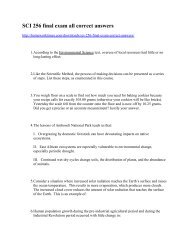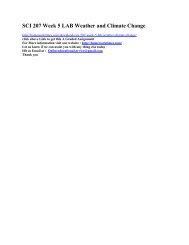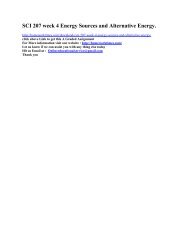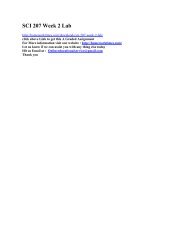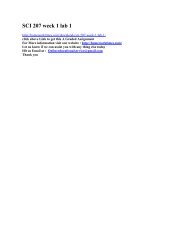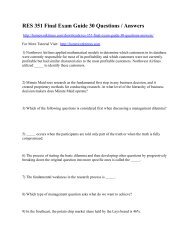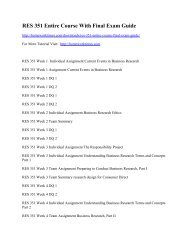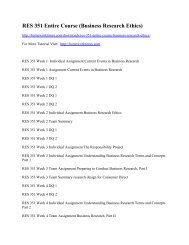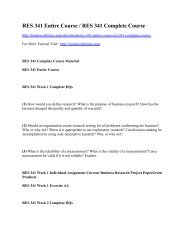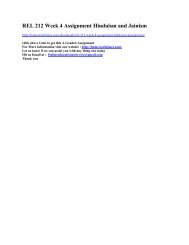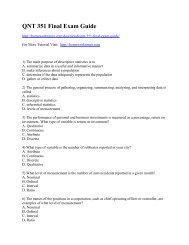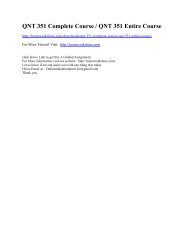QNT 561 Final Exam
You also want an ePaper? Increase the reach of your titles
YUMPU automatically turns print PDFs into web optimized ePapers that Google loves.
<strong>QNT</strong> <strong>561</strong> <strong>Final</strong> <strong>Exam</strong><br />
http://homeworktimes.com/downloads/qnt-<strong>561</strong>-final-exam/<br />
1) The main purpose of descriptive statistics is to<br />
A. summarize data in a useful and informative manner<br />
B. make inferences about a population<br />
C. determine if the data adequately represents the population<br />
D. gather or collect data<br />
2) The general process of gathering, organizing, summarizing, analyzing, and interpreting data is<br />
called<br />
A. statistics<br />
B. descriptive statistics<br />
C. inferential statistics<br />
D. levels of measurement<br />
3) The performance of personal and business investments is measured as a percentage, return on<br />
investment. What type of variable is return on investment?<br />
A. Qualitative<br />
B. Continuous<br />
C. Attribute<br />
D. Discrete<br />
4) What type of variable is the number of robberies reported in your city?<br />
A. Attribute<br />
B. Continuous<br />
C. Discrete<br />
D. Qualitative<br />
5) What level of measurement is the number of auto accidents reported in a given month?<br />
A. Nominal<br />
B. Ordinal<br />
C. Interval<br />
D. Ratio<br />
6) The names of the positions in a corporation, such as chief operating officer or controller, are<br />
examples of what level of measurement?<br />
A. Nominal<br />
B. Ordinal<br />
C. Interval<br />
D. Ratio
7) Shoe sizes, such as 7B, 10D, and 12EEE, are examples of what level of measurement?<br />
A. Nominal<br />
B. Ordinal<br />
C. Interval<br />
D. Ratio<br />
8) Monthly commissions of first-year insurance brokers are $1,270, $1,310, $1,680, $1,380,<br />
$1,410, $1,570, $1,180, and $1,420. These figures are referred to as<br />
A. a histogram<br />
B. raw data<br />
C. frequency distribution<br />
D. frequency polygon<br />
9) A small sample of computer operators shows monthly incomes of $1,950, $1,775, $2,060,<br />
$1,840, $1,795, $1,890, $1,925, and $1,810. What are these ungrouped numbers called?<br />
A. Histogram<br />
B. Class limits<br />
C. Class frequencies<br />
D. Raw data<br />
10) The sum of the deviations of each data value from this measure of central location will<br />
always be 0.<br />
A. Mode<br />
B. Mean<br />
C. Median<br />
D. Standard deviation<br />
11) For any data set, which measures of central location have only one value?<br />
A. Mode and median<br />
B. Mode and mean<br />
C. Mode and standard deviation<br />
D. Mean and median<br />
12) A sample of single persons receiving social security payments revealed these monthly<br />
benefits: $826, $699, $1,087, $880, $839, and $965. How many observations are below the<br />
median?<br />
A. 0<br />
B. 1<br />
C. 2<br />
D. 3<br />
13) A dot plot shows<br />
A. the general shape of a distribution<br />
B. the mean, median, and mode<br />
C. the relationship between two variables<br />
D. the interquartile range
14) The test scores for a class of 147 students are computed. What is the location of the test score<br />
associated with the third quartile?<br />
A. 111<br />
B. 37<br />
C. 74<br />
D. 75%<br />
15) The National Center for Health Statistics reported that of every 883 deaths in recent years, 24<br />
resulted from an automobile accident, 182 from cancer, and 333 from heart disease. Using the<br />
relative frequency approach, what is the probability that a particular death is due to an<br />
automobile accident?<br />
A. 24/883 or 0.027<br />
B. 539/883 or 0.610<br />
C. 24/333 or 0.072<br />
D. 182/883 or 0.206<br />
16) If two events A and B are mutually exclusive, what does the special rule of addition state?<br />
A. P(A or B) = P(A) + P(B)<br />
B. P(A and B) = P(A) + P(B)<br />
C. P(A and/or B) = P(A) + P(B)<br />
D. P(A or B) = P(A) – P(B)<br />
17) A listing of all possible outcomes of an experiment and their corresponding probability of<br />
occurrence is called a<br />
A. random variable<br />
B. probability distribution<br />
C. subjective probability<br />
D. frequency distribution<br />
18) The shape of any uniform probability distribution is<br />
A. negatively skewed<br />
B. positively skewed<br />
C. rectangular<br />
D. bell shaped<br />
19) The mean of any uniform probability distribution is<br />
A. (b – a)/2<br />
B. (a + b)/2<br />
C. Σ x/ η<br />
D. nπ<br />
20) For the normal distribution, the mean plus and minus 1.96 standard deviations will include<br />
about what percent of the observations?<br />
A. 50%<br />
B. 99.7%
C. 95%<br />
D. 68%<br />
21) For a standard normal distribution, what is the probability that z is greater than 1.75?<br />
A. 0.0401<br />
B. 0.0459<br />
C. 0.4599<br />
D. 0.9599<br />
22) A null hypothesis makes a claim about a<br />
A. population parameter<br />
B. sample statistic<br />
C. sample mean<br />
D. Type II error<br />
23) What is the level of significance?<br />
A. Probability of a Type II error<br />
B. Probability of a Type I error<br />
C. z-value of 1.96<br />
D. Beta error<br />
24) Suppose we test the difference between two proportions at the 0.05 level of significance. If<br />
the computed z is -1.07, what is our decision?<br />
A. Reject the null hypothesis.<br />
B. Do not reject the null hypothesis.<br />
C. Take a larger sample.<br />
D. Reserve judgment.<br />
25- Which of the following conditions must be met to conduct a test for the difference in two<br />
sample means?<br />
A. Data must be at least of interval scale.<br />
B. Populations must be normal.<br />
C. Variances in the two populations must be equal.<br />
D. Data must be at least of interval scale and populations must be normal.<br />
26- For a hypothesis test comparing two population means, the combined degrees of freedom are<br />
24. Which of the following statements about the two sample sizes in NOT true? Assume the<br />
population standard deviations are equal.<br />
A. Sample A = 11, Sample B = 13
B. Sample A = 12, Sample B = 14<br />
C. Sample A = 13, Sample B = 13<br />
D. Sample A = 10, Sample B = 16<br />
27- What is the chart called when the paired data (the dependent and independent variables) are<br />
plotted?<br />
A. Scatter diagram<br />
B. Bar chart<br />
C. Pie chart<br />
D. Histogram<br />
28- What is the variable used to predict the value of another called?<br />
A. Independent variable<br />
B. Bar chart<br />
C. Pie chart<br />
D. Histogram<br />
29- Twenty randomly selected statistics students were given 15 multiple-choice questions and 15<br />
open-ended questions, all on the same Material. The professor was interested in determining on<br />
which type of questions the students scored higher. This experiment is an example of<br />
A. a one sample test of means<br />
B. a two sample test of means<br />
C. a paired t-test<br />
D. a test of proportions
30- The measurements of weight of 100 units of a product manufactured by two parallel<br />
processes have same mean but the standard of process A is 15 while that of B is 7. What can you<br />
conclude?<br />
A. The weight of units in process A are grouped closer than in process B.<br />
B. The weight of units in process B are grouped closer than in process A.<br />
C. Both processes are out of control.<br />
D. More data is needed to draw a conclusion.<br />
TO DOWNLOAD ALL ANSWERS CLICK ON PURCHASE BUTTON



